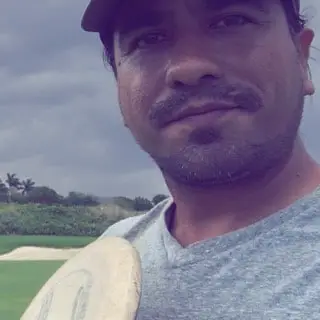Sure keeping score in disc golf is as easy as counting each throw you make as a stroke. Keep track of all throws for each hole. All holes are tallied up and in the end, the player with the lowest score wins. But what happens when someone passes you the scorecard because it’s your turn to keep score? This post will help you confidently and accurately keep score for yourself and your card mates. Let’s get started.
The basics
Taking score in disc golf is pretty straightforward and being so similar to traditional golf many already know the basics. But when it comes down to it, accurately taking down scores for yourself and others, keeps the game fair, transparent, and competitive.
If you’re given the responsibility to keep score during a round and you’re not quite sure of all the marks to place on the card know just this one basic rule. Always put the total number of throws a player made for a hole including penalty strokes and penalty throws. That’s it. After your round and after your card mates look at the card they can then teach you how to mark for birdies and other details.
Always play holes as par 3 if you’re new to the course and can’t find info. This keeps for simple score keeping.
If you’re playing a course with friends that you’ve never been to and you don’t know what par is for every hole here’s a tip. Always play holes as par 3 if you’re new to the course and can’t find this info. This will keep things simple.
But if you’re ready to get a grip on how to use a scorecard then read on!
Breaking down a scorecard
Here’s a breakdown of most things you’ll find on a disc golf scorecard.
- Course Name: If there’s a spot for the course name write it in.
- Distances: Some printable course scorecards have the distance for each hole.
- Par: The par for each hole.
- Players’ name: Write each player’s name here.
- Holes: This is the number for each hole. If you happen to start on a hole other than 1, start on that hole for scorekeeping as well.
- Front 9 score: Place the total strokes for the front nine holes here.
- Back 9 score: Place the total strokes for the back nine holes here.
- Total score: Place combined front and back nine totals here for a final total score.
- Over Under Course Par: If course par is 54 (18 holes at par 3 each) and you threw a 56 you’d place a +2 here because you’re 2 strokes over par. If you shot a 52 you’d place a -2 here because you threw 2 strokes under par.
Who takes score first
The person at the top of the card is the first person to take the score. During friendly rounds, anyone may volunteer to take score if it’s fine with the rest of the group. During most friendly rounds players will keep track of their own score. We’ll do this either with our own card, app, or mentally. It’s easy to keep your score mentally by using the over and under method. We’ll discuss this in another post.
In a tournament, however, you’ll probably not want to hold on to that distraction of scorekeeping for too long.
If you have the scorecard first, keep it for about 4-5 holes if you have four players on your card. Pass it on to the next player on the card order and continue this method. All players will have a chance to keep score and also keep that distraction. In a tournament, if the group decides we’ll take turns keeping score then ALL players must have an equal amount of scorekeeping duties during that round.
Writing player names
Before you start writing the players names down you should know this is the order you’ll be starting in. If it’s random order just place the names in random order and get started.
In friendly rounds we flip discs and find the order that way. In tournaments the order is usually placed by the tournament director or staff. This may sound minor but if you’re given scorecard duties at any event you’ll want to know the starting order before placing the names on the card.
What is par for each hole
If you print a card for a course they may have the par for each hole already on it. If not and you know the par for each hole, feel free to write that in for reference.
If you’re playing a course that has all par 3 holes writing it in may be obsolete. Writing the par for each hole can be great for rounds during your travels for memories as well.
Start on the right hole
As mentioned above you can’t always start on hole one for your round. Sometimes you may have to start on hole 4 or hole 9. In my home course, we often have to start on hole five because of other course and park users.
So, in this event when you have to start on hole 5 for example. You’d want to start score taking in the hole 5 slot. This is especially helpful on a course that have various pars for each hole.
Always let your card mates know before you make ANY changes to the scorecard.
If you’re on a card and realize you’ve made a mistake in where you started, get your card mates’ attention and let them know you need to make some adjustments. Always let your card mates know before you make ANY changes to the scorecard. Agree on the necessary changes and then make the adjustments.
How to mark penalties
Let’s say you go out of bounds and or bunker and so receive a penalty stroke. You don’t need to mark the scorecard differently when a player receives a penalty in most cases. If you’re beginning just keep it simple and add all penalties to the stroke total.
If you’re playing in a tournament and a player receives a penalty for an infraction there are different ways to mark a card. If a player receives a second foot fault warning they’d then receive a penalty stroke. The stroke is added to the hole like normally and then you’d want to note a P for that hole. Marks for that hole are helpful if the tournament director is needed for later approval. There are other reasons to note infractions on a scorecard but we’ll save that for another post and keep this one for the basics.
How to mark birdies
A birdie is when you score one stroke under par for a hole. For example if a hole is par 4 and you shoot a 3 that’s a birdie and we love birdies!
Simply place a 3 for your score on that hole. For quick reference, we like to circle the birdies. This is especially helpful if the par for each hole Isn’t on the scorecard, to begin with. marking each birdie with a circle makes it easier to add up the scores at the end.
How to mark eagles
Eagles are less common than birdies but they happen. Since they’re not as common there is no need to mark the scorecard and a special way. Just place the number of throws made like usual.
Mistakes will happen
Never make changes or erase anyone’s score until you run it by your card mates. Nobody likes to look over to see someone erasing things on the scorecard and making any changes. Whether it be your score or other players always, always get it approved by all players on the card.
Tallying up the totals
After your round is over it’s time to add up the scores. Take the total for the front 9 holes and add it to the corresponding box. Then do the same for the back nine. Add then add them together and you’ll have your total score which you’ll add to the totals box. Continue to do the same for all players.
All players inspect the scorecard
One player will add up all the scores for the players on the card. After that, each player will go over the math for ALL players and not just their own. If any errors are found all players must go over any changes before they are made.
After each player has gone over their scores, we usually will initial by our total to mark that we agree with the accuracy cards being turned in.
Turn scorecards in 100% completed and error free
Before turning in your cards for a tournament make sure they’ve been signed-off by all players first. At some events, errors on the scorecard can result in penalties so this is why proper scorekeeping is important to learn as well as find any errors before turning them in.


